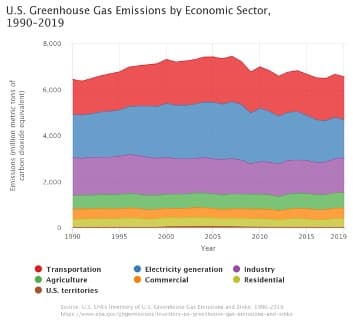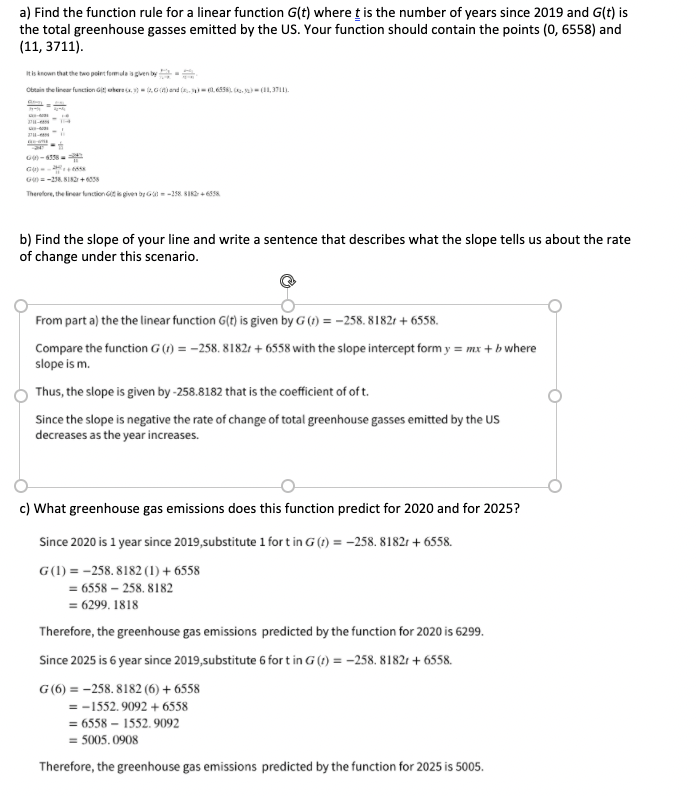d) Compare the predicted change in greenhouse gas emissions between 2020 and 2025 to the change between 2025 and 2030? During which five-year period is the predicted change greater and by how much or is it the same in the two-time periods? e) During what year does this function rule predict that the US emission of greenhouse gasses will decrease to 1000 million metric tons of carbon dioxide equivalents?
d) Compare the predicted change in greenhouse gas emissions between 2020 and 2025 to the change between 2025 and 2030? During which five-year period is the predicted change greater and by how much or is it the same in the two-time periods? e) During what year does this function rule predict that the US emission of greenhouse gasses will decrease to 1000 million metric tons of carbon dioxide equivalents?
Algebra and Trigonometry (6th Edition)
6th Edition
ISBN:9780134463216
Author:Robert F. Blitzer
Publisher:Robert F. Blitzer
ChapterP: Prerequisites: Fundamental Concepts Of Algebra
Section: Chapter Questions
Problem 1MCCP: In Exercises 1-25, simplify the given expression or perform the indicated operation (and simplify,...
Related questions
Question
I have attached my answer to be compared with the 2 subparts. D and E
d) Compare the predicted change in greenhouse gas emissions between 2020 and 2025 to the change between 2025 and 2030? During which five-year period is the predicted change greater and by how much or is it the same in the two-time periods?
e) During what year does this function rule predict that the US emission of greenhouse gasses will decrease to 1000 million metric tons of carbon dioxide equivalents?

Transcribed Image Text:U.S. Greenhouse Gas Emissions by Economic Sector,
1990-2019
8.000
6,c00
4,000
2,000
1990
1995
2000
2005
2010
2015
2019
Year
Transportation
Electricity generation
Industry
Agriculture
Commercial
Residential
US. territories
Source. U.S. EWa Invertory of US. Greenheune G Emaoro and Sinks. 1900-2019.
htps www.epa.pov/gtomsomireniery-n-greeshouie-gis-emissisra-and-airks
Emissions (million metric tons of
carbon diaxide equivalent)

Transcribed Image Text:a) Find the function rule for a linear function G(t) where t is the number of years since 2019 and G(t) is
the total greenhouse gasses emitted by the US. Your function should contain the points (0, 6558) and
(11, 3711).
tis known that the two poirt fomula a gven by
Obtain the linear function Git ehers , - .G ()and (a. .6558,. . a(1, 371).
Gu)-
G = -238. KI+08
Therelore, the inear function t is given by Gt--18 SIKS + 6558
b) Find the slope of your line and write a sentence that describes what the slope tells us about the rate
of change under this scenario.
From part a) the the linear function G(t) is given by G (1) = -258. 8182r + 6558.
Compare the function G (1) = -258. 81821 + 6558 with the slope intercept form y = mx + b where
slope is m.
Thus, the slope is given by -258.8182 that is the coefficient of of t.
Since the slope is negative the rate of change of total greenhouse gasses emitted by the Us
decreases as the year increases.
c) What greenhouse gas emissions does this function predict for 2020 and for 2025?
Since 2020 is 1 year since 2019,substitute 1 for t in G (?) = -258. 8182r + 6558.
G(1) = -258. 8182 (1) + 6558
= 6558 – 258. 8182
= 6299. 1818
Therefore, the greenhouse gas emissions predicted by the function for 2020 is 6299.
Since 2025 is 6 year since 2019,substitute 6 fort in G (?) = -258. 81821 + 6558.
G (6) = -258. 8182 (6) + 6558
= -1552. 9092 + 6558
= 6558 – 1552. 9092
= 5005. 0908
Therefore, the greenhouse gas emissions predicted by the function for 2025 is 5005.
Expert Solution
This question has been solved!
Explore an expertly crafted, step-by-step solution for a thorough understanding of key concepts.
Step by step
Solved in 3 steps

Recommended textbooks for you

Algebra and Trigonometry (6th Edition)
Algebra
ISBN:
9780134463216
Author:
Robert F. Blitzer
Publisher:
PEARSON

Contemporary Abstract Algebra
Algebra
ISBN:
9781305657960
Author:
Joseph Gallian
Publisher:
Cengage Learning

Linear Algebra: A Modern Introduction
Algebra
ISBN:
9781285463247
Author:
David Poole
Publisher:
Cengage Learning

Algebra and Trigonometry (6th Edition)
Algebra
ISBN:
9780134463216
Author:
Robert F. Blitzer
Publisher:
PEARSON

Contemporary Abstract Algebra
Algebra
ISBN:
9781305657960
Author:
Joseph Gallian
Publisher:
Cengage Learning

Linear Algebra: A Modern Introduction
Algebra
ISBN:
9781285463247
Author:
David Poole
Publisher:
Cengage Learning

Algebra And Trigonometry (11th Edition)
Algebra
ISBN:
9780135163078
Author:
Michael Sullivan
Publisher:
PEARSON

Introduction to Linear Algebra, Fifth Edition
Algebra
ISBN:
9780980232776
Author:
Gilbert Strang
Publisher:
Wellesley-Cambridge Press

College Algebra (Collegiate Math)
Algebra
ISBN:
9780077836344
Author:
Julie Miller, Donna Gerken
Publisher:
McGraw-Hill Education